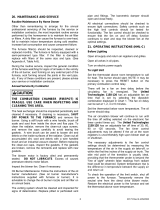
Thermostat wiring connections and air conditioning
contactor low voltage connections are shown in the
wiring diagrams in Appendix B. Some micro-electronic
thermostats require additional controls and wiring.
Refer to the thermostat manufacturer's instructions.
The thermostat should be located approximately 5 feet
above the floor, on an inside wall where there is good
natural air circulation, and where the thermostat will be
exposed to average room temperatures. Avoid
locations where the thermostat will be exposed to cold
drafts, heat from nearby lamps and appliances,
exposure to sunlight, heat from inside wall stacks, etc.
The thermostat heat anticipator should be adjusted to
the amperage draw of the heating control circuit as
measured at the "R" and "W" terminals of the
thermostat. To reduce the risk of damaging the heat
anticipator, do not measure this current with the
thermostat connected to the circuit. Measure the
amperage by connecting an ammeter between the two
wires that will connect to the thermostat "R" and "W"
terminals.
10. HUMIDIFIER
A humidifier is an optional accessory available through
most heating supplies outlets. Installation should be
carried out in accordance with the humidifier
manufacturer's installation instructions. Water or water
droplets from the humidifier should not be allowed to
come into contact with the furnace heat exchanger. Do
not use direct drive motor connections as a source of
power for 120 VAC humidifiers and humidifier
transformers.
6
11. PIPING INSTALLATION
The entire fuel system should be installed in
accordance with the requirement of CAN/CSA B-139,
and local regulations. Use only an approved fuel oil
tanks piping, fittings and oil filter.
In the United States the installation must be in
accordance with NFPA No. 31 and local codes and
authorities.
Install the oil filter as close to the burner as possible.
For further details of the oil supply tank and piping
requirements, please refer to the instructions and
illustrations in the oil burner and oil pump instructions
shipped with the furnace.
12. OIL FILTER
All fuel systems should include an oil filter
between the fuel oil storage tank and the oil
burner. When using an oil burner nozzle smaller
than 0.65 U.S. Gallons Per Hour, install an
additional 7 to 10 micron filter as close as
possible to the oil burner.
13. OIL BURNER NOZZLES
The O5LD-091A-12-R is certified for multiple firing
rates, ranging from 70,000 to 105,000 Btu/h. By
manipulating the oil burner nozzle, flame retention
head, static plate and temperature rise; the furnace
may be fired at an ideal rate for a wide range of
structures. Refer to Table A-1, and the furnace rating
plate to determine the proper combinations.
14. OIL BURNER ADJUSTMENT
The burner air supply is adjusted to maintain the fuel to
air ratio to obtain ideal combustion conditions. A lack of
air causes "soft" and "sooty" flames, resulting in soot
build-up throughout the heat exchanger passages.
Excess combustion air causes a bright roaring fire and
high stack temperatures resulting in poor fuel
efficiency. The O5LD-091A-12-R furnace operates
most efficiently with a No. 1 smoke spot on the
Bacharach Scale. This is not necessarily the optimum
setting; however, because dust will inevitably build up
on the air moving components of the oil burner
assembly. This will result in decreased air supply with
the potential result of soot building up in the flue gas
passageways of the heat exchanger. Soot behaves as
an insulator and impairs good heat transfer. Stack
temperature will increase, and the overall efficiency will
decrease. As a means of avoiding this problem, it is
advisable to adjust the air supply to provide no more
than a trace smoke spot on the Bacharach Scale.
BEFORE OPERATING THE FURNACE
CHECK BURNER ALIGNMENT WITH
COMBUSTION CHAMBER. THE END
CONE OF THE AIR TUBE MUST BE
CENTRED TO THE ACCOMODATING
RING PROVIDED IN THE DESIGN OF
THE COMBUSTION CHAMBER. ADJUST
AS NECESSARY.
15. BURNER ELECTRODES
Correct positioning of the electrode tips with respect to
each other, to the fuel oil nozzle, and to the rest of the
burners is essential for smooth light ups and proper
operation. Refer to the oil burner instructions shipped
with the furnace for electrode specifications.
NOTE: Beckett AF Series Burner electrode
specifications have been revised. They should be
adjusted to be 5/16” above the nozzle centerline.




















